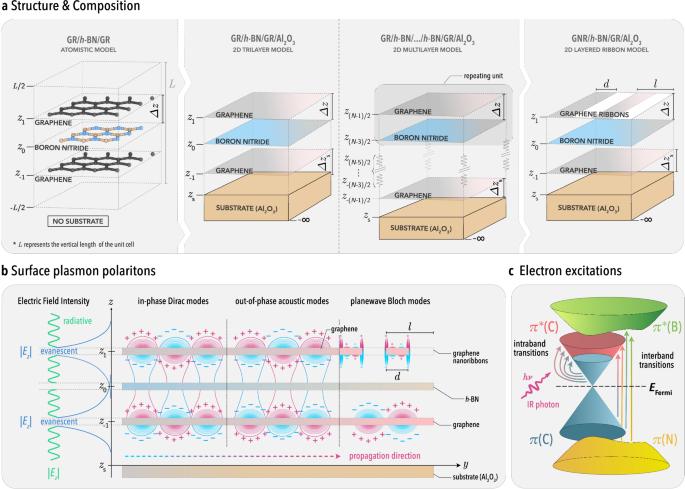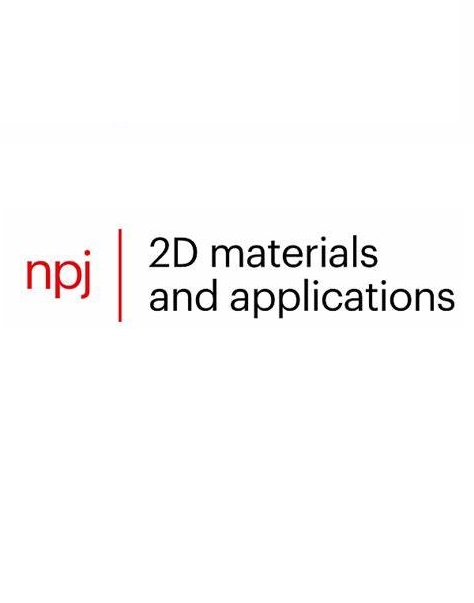Tailored plasmon polariton landscape in graphene/boron nitride patterned heterostructures
IF 8.8
2区 材料科学
Q1 MATERIALS SCIENCE, MULTIDISCIPLINARY
引用次数: 0
Abstract
Surface plasmon polaritons (SPPs), which are electromagnetic modes representing collective oscillations of charge density coupled with photons, have been extensively studied in graphene. This has provided a solid foundation for understanding SPPs in 2D materials. However, the emergence of wafer-transfer techniques has led to the creation of various quasi-2D van der Waals heterostructures, highlighting certain gaps in our understanding of their optical properties in relation to SPPs. To address this, we analyzed electromagnetic modes in graphene/hexagonal-boron-nitride/graphene heterostructures on a dielectric Al2O3 substrate using the full ab initio RPA optical conductivity tensor. Our theoretical model was validated through comparison with recent experiments measuring evanescent in-phase Dirac and out-of-phase acoustic SPP branches. Furthermore, we investigate how the number of plasmon branches and their dispersion are sensitive to variables such as layer count and charge doping. Notably, we demonstrate that patterning of the topmost graphene into nanoribbons provides efficient Umklapp scattering of the bottommost Dirac plasmon polariton (DP) into the radiative region, resulting in the conversion of the DP into a robust infrared-active plasmon. Additionally, we show that the optical activity of the DP and its hybridization with inherent plasmon resonances in graphene nanoribbons are highly sensitive to the doping of both the topmost and bottommost graphene layers. By elucidating these optical characteristics, we aspire to catalyze further advancements and create new opportunities for innovative applications in photonics and optoelectronic integration.

石墨烯/氮化硼图案异质结构中的定制等离子体极化子景观
石墨烯中的表面等离子体极化子(SPPs)是一种电磁模式,代表了电荷密度与光子耦合的集体振荡。这为了解二维材料中的 SPPs 奠定了坚实的基础。然而,晶圆转移技术的出现导致了各种准二维范德瓦尔斯异质结构的产生,凸显了我们对其与 SPPs 相关的光学特性认识上的某些差距。为了解决这个问题,我们使用全 ab initio RPA 光传导张量分析了电介质 Al2O3 衬底上的石墨烯/六方硼氮化物/石墨烯异质结构中的电磁模式。我们的理论模型与最近测量蒸发相内狄拉克和相外声波 SPP 分支的实验进行了比较验证。此外,我们还研究了等离子体分支的数量及其分散如何对层数和电荷掺杂等变量敏感。值得注意的是,我们证明了将最顶层的石墨烯图案化为纳米带可将最底层的狄拉克等离子体极化子(DP)有效地散射到辐射区域,从而将 DP 转换为强大的红外活性等离子体。此外,我们还证明了 DP 的光学活性及其与石墨烯纳米带中固有等离子体共振的杂化对最顶层和最底层石墨烯层的掺杂高度敏感。通过阐明这些光学特性,我们希望推动进一步的进步,并为光子学和光电集成的创新应用创造新的机遇。
本文章由计算机程序翻译,如有差异,请以英文原文为准。
求助全文
约1分钟内获得全文
求助全文
来源期刊

npj 2D Materials and Applications
Engineering-Mechanics of Materials
CiteScore
14.50
自引率
2.10%
发文量
80
审稿时长
15 weeks
期刊介绍:
npj 2D Materials and Applications publishes papers on the fundamental behavior, synthesis, properties and applications of existing and emerging 2D materials. By selecting papers with the potential for impact, the journal aims to facilitate the transfer of the research of 2D materials into wide-ranging applications.
 求助内容:
求助内容: 应助结果提醒方式:
应助结果提醒方式:


